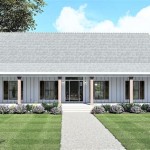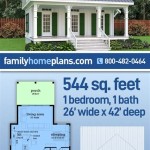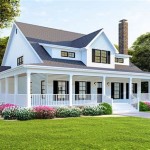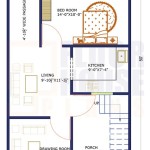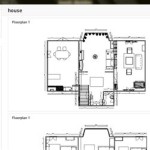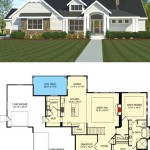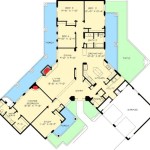House Plan With In Law Suite: A Comprehensive Guide
The concept of a house plan with an in-law suite, also known as an accessory dwelling unit (ADU) or a multigenerational living space, is gaining significant traction in contemporary residential architecture. These suites are designed to provide independent living spaces within a larger home, catering to the needs of aging parents, adult children returning home, or even renters, while maintaining a degree of separation and privacy for all occupants. Understanding the nuances of such house plans requires careful consideration of several factors, from legal implications and design considerations to practical aspects of construction and future adaptability.
A house plan with an in-law suite goes beyond simply adding an extra bedroom and bathroom. It involves creating a self-contained unit with its own entrance, kitchen or kitchenette, living area, and bathroom. This allows the occupant to live relatively independently while still being connected to the main residence. The specific design and features of an in-law suite can vary considerably depending on the needs and preferences of the intended occupant, the available space, and the overall architectural style of the house.
Understanding the Benefits of In-Law Suites
The incorporation of an in-law suite into a house plan offers a multitude of advantages, appealing to a wide range of homeowners. One of the primary benefits is facilitating multigenerational living. As the population ages and families seek ways to care for elderly relatives, in-law suites provide a practical and comfortable solution. They allow seniors to maintain their independence while remaining close to family members who can provide support and assistance when needed. This arrangement fosters stronger family bonds and reduces the stress and cost associated with assisted living facilities.
Beyond multigenerational living, in-law suites can also serve as a source of rental income. Homeowners can lease the suite to tenants, providing a valuable source of revenue that can help offset mortgage payments or other household expenses. This option is particularly attractive in areas with high rental demand or limited affordable housing options. Before pursuing this route, it's crucial to thoroughly research local zoning regulations and landlord-tenant laws to ensure compliance.
Flexibility is another key advantage. An in-law suite can adapt to changing needs over time. It can initially serve as housing for an aging parent, later transition into a space for an adult child saving for their own home, and eventually be used as a guest suite or home office. This adaptability makes a house with an in-law suite a valuable asset in the long run.
Key Design Considerations for In-Law Suites
Designing an effective in-law suite requires careful planning and consideration of several key design elements. Accessibility is paramount, particularly if the suite is intended for elderly or disabled occupants. Features such as wider doorways, grab bars in bathrooms, and ramped entrances should be incorporated to ensure ease of movement and safety. Universal design principles, which focus on creating spaces usable by people of all abilities, are highly recommended.
Privacy is another crucial aspect to consider. While the occupants of the in-law suite are part of the same household, it's important to provide them with a sense of autonomy and separation. A separate entrance is essential for maintaining privacy and independence. Soundproofing measures, such as insulated walls and floors, can also help minimize noise transfer between the suite and the main residence. Furthermore, consider the placement of windows and doors to ensure visual privacy.
The layout and functionality of the in-law suite should be tailored to the needs of the intended occupant. A full kitchen, including appliances such as a refrigerator, stove, and microwave, is often desirable. A comfortable living area and well-appointed bathroom are also essential. Consider incorporating features that promote independence, such as a washer and dryer within the suite. Adequate storage space is also critical for maintaining an organized and clutter-free living environment.
Integration with the main house also needs to be addressed. While the in-law suite should function as a separate unit, it should also blend seamlessly with the overall architectural style of the house. Consider the materials, colors, and finishes used in the suite to ensure they complement the existing design. Maintaining a consistent aesthetic throughout the house will enhance its curb appeal and resale value.
Navigating Legal and Regulatory Requirements
Constructing or renovating a house to include an in-law suite involves navigating a complex web of legal and regulatory requirements. Zoning ordinances often dictate the permissible uses of properties and may restrict the creation of accessory dwelling units in certain areas. It's crucial to thoroughly research local zoning regulations to determine whether an in-law suite is allowed and what specific restrictions apply.
Building codes also play a significant role. These codes specify the minimum standards for construction, including safety, structural integrity, and energy efficiency. An in-law suite must comply with all applicable building codes, which may require obtaining permits and inspections. Failure to comply with building codes can result in fines, delays, and even legal action.
Property taxes can also be affected by the addition of an in-law suite. Increasing the living space of a property typically results in a higher assessed value, which in turn leads to higher property taxes. It's advisable to consult with a local tax assessor to understand the potential tax implications of adding an in-law suite.
Furthermore, homeowners association (HOA) rules and regulations may also restrict the construction or use of in-law suites. Many HOAs have specific guidelines regarding architectural design, property use, and rental restrictions. It's essential to review the HOA documents carefully before proceeding with any construction or renovation plans.
Financing the construction or renovation of a house to include an in-law suite may require exploring different loan options. Traditional mortgages, home equity loans, and construction loans are all potential sources of funding. The best option will depend on the homeowner's individual financial circumstances and the scope of the project. It's advisable to consult with a financial advisor to determine the most suitable financing strategy.
In summary, designing and building a house plan with an in-law suite is a multifaceted process that requires careful planning, attention to detail, and adherence to legal and regulatory requirements. By thoroughly researching all aspects of the project and working with qualified professionals, homeowners can create a functional, comfortable, and valuable addition to their property.
The decision to incorporate an in-law suite into a house plan is a significant one that should be carefully considered. It's essential to weigh the potential benefits against the costs and challenges involved. However, for many families, the advantages of multigenerational living, rental income potential, and increased flexibility make in-law suites a worthwhile investment.
The increasing popularity of in-law suites reflects a growing trend towards adaptable and sustainable housing solutions. As families seek ways to address the challenges of an aging population and rising housing costs, in-law suites offer a viable and attractive option. By carefully planning and executing the design and construction of an in-law suite, homeowners can create a valuable asset that enhances their quality of life and provides for the needs of their families for years to come.
Ultimately, the success of a house plan with an in-law suite depends on creating a space that is both functional and comfortable, providing independence and privacy while fostering a sense of connection and community within the household. This requires careful consideration of the needs and preferences of all occupants, as well as a commitment to quality design and construction.

Southern Style House Plan With In Law Suite

House Plan 65862 Tuscan Style With 2091 Sq Ft 3 Bed 2 Bath 1

In Law Suite Plans Give Mom Space And Keep Yours The House Designers

Impressive Home Plans With Inlaw Suites 8 House In Law Suite Floor Modular One Story Multigenerational

Homes With Mother In Law Suites

House Plans With In Law Suites Houseplans Blog Com

Modern Farmhouse Plan With In Law Suite 70607mk Architectural Designs House Plans

Updated Farmhouse Style House Plan 7382 Pinecone Trail

Front Side View House Plans With A Separate In Law Suite

Cape Cod House Plans With Inlaw Suite Best Of Mother In New Multigenerational Country

